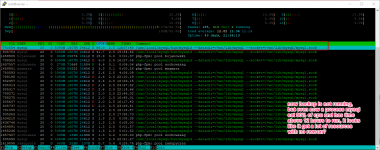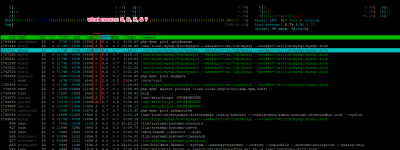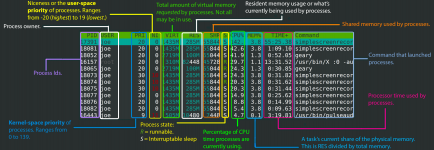I have more detailed report od mysqltuner, if you can look at it and just tell your first conclusion what to check on first sight, I will be very grateful.
root@server ~ # ./mysqltuner.pl
>> MySQLTuner 2.5.3
* Jean-Marie Renouard <
[email protected]>
* Major Hayden <
[email protected]>
>> Bug reports, feature requests, and downloads at
http://mysqltuner.pl/
>> Run with '--help' for additional options and output filtering
[--] Skipped version check for MySQLTuner script
[OK] Operating on 64-bit architecture
-------- Storage Engine Statistics ------------------------------------------------------------- ----
[--] Status: +Aria +CSV +InnoDB +MEMORY +MRG_MyISAM +MyISAM +PERFORMANCE_SCHEMA +SEQUENCE
[--] Data in Aria tables: 32.0K (Tables: 1)
[--] Data in MyISAM tables: 107.4M (Tables: 424)
[--] Data in MEMORY tables: 0B (Tables: 15)
[--] Data in InnoDB tables: 4.8G (Tables: 7632)
[OK] Total fragmented tables: 0
[OK] Currently running supported MySQL version 10.6.17-MariaDB
-------- Log file Recommendations -------------------------------------------------------------- ----
[!!] Log file doesn't exist
-------- Analysis Performance Metrics ---------------------------------------------------------- ----
[--] innodb_stats_on_metadata: OFF
[OK] No stat updates during querying INFORMATION_SCHEMA.
-------- Views Metrics ------------------------------------------------------------------------- ----
-------- Triggers Metrics ---------------------------------------------------------------------- ----
-------- Routines Metrics ---------------------------------------------------------------------- ----
-------- Security Recommendations -------------------------------------------------------------- ----
[!!] User ''@'localhost' is an anonymous account. Remove with DROP USER ''@'localhost';
[!!] User ''@'server' is an anonymous account. Remove with DROP USER ''@'s erver-IP.da.direct';
[OK] All database users have passwords assigned
[--] There are 620 basic passwords in the list.
-------- CVE Security Recommendations ---------------------------------------------------------- ----
[OK] NO SECURITY CVE FOUND FOR YOUR VERSION
-------- Performance Metrics ------------------------------------------------------------------- ----
[--] Up for: 22h 56m 57s (17M q [215.357 qps], 142K conn, TX: 124G, RX: 3G)
[--] Reads / Writes: 98% / 2%
[--] Binary logging is disabled
[--] Physical Memory : 62.7G
[--] Max MySQL memory : 861.2M
[--] Other process memory: 0B
[--] Total buffers: 417.0M global + 2.9M per thread (151 max threads)
[--] Performance_schema Max memory usage: 0B
[--] Galera GCache Max memory usage: 0B
[OK] Maximum reached memory usage: 517.0M (0.81% of installed RAM)
[OK] Maximum possible memory usage: 861.2M (1.34% of installed RAM)
[OK] Overall possible memory usage with other process is compatible with memory available
[OK] Slow queries: 0% (23K/17M)
[OK] Highest usage of available connections: 22% (34/151)
[OK] Aborted connections: 0.00% (7/142143)
[!!] Name resolution is active: a reverse name resolution is made for each new connection which can reduce performance
[OK] Query cache is disabled by default due to mutex contention on multiprocessor machines.
[OK] Sorts requiring temporary tables: 0% (840 temp sorts / 2M sorts)
[!!] Joins performed without indexes: 115233
[!!] Temporary tables created on disk: 27% (528K on disk / 1M total)
[OK] Thread cache hit rate: 99% (34 created / 142K connections)
[OK] Table cache hit rate: 91% (24M hits / 27M requests)
[!!] table_definition_cache (400) is less than number of tables (8363)
[OK] Open file limit used: 0% (248/32K)
[OK] Table locks acquired immediately: 99% (632K immediate / 632K locks)
-------- Performance schema -------------------------------------------------------------------- ----
[!!] Performance_schema should be activated.
[--] Sys schema is installed.
-------- ThreadPool Metrics -------------------------------------------------------------------- ----
[--] ThreadPool stat is disabled.
-------- MyISAM Metrics ------------------------------------------------------------------------ ----
[!!] Consider migrating 424 following tables to InnoDB:
[--] * InnoDB migration request for testowy_spes.wpuo_usermeta Table: ALTER TABLE testowy_spes.w puo_usermeta ENGINE=InnoDB;
[--] * InnoDB migration request for testowy_spes.wpuo_postmeta Table: ALTER TABLE testowy_spes.w puo_postmeta ENGINE=InnoDB;
[--] * InnoDB migration request for testowy_spes.wpuo_links Table: ALTER TABLE testowy_spes.wpuo _links ENGINE=InnoDB;
[--] * InnoDB migration request for testowy_spes.wpuo_term_relationships Table: ALTER TABLE test owy_spes.wpuo_term_relationships ENGINE=InnoDB;
[--] * InnoDB migration request for testowy_spes.wpuo_options Table: ALTER TABLE testowy_spes.wp uo_options ENGINE=InnoDB;
[--] * InnoDB migration request for testowy_spes.wpuo_terms Table: ALTER TABLE testowy_spes.wpuo _terms ENGINE=InnoDB;
[--] * InnoDB migration request for testowy_spes.wpuo_users Table: ALTER TABLE testowy_spes.wpuo _users ENGINE=InnoDB;
[--] * InnoDB migration request for testowy_spes.wpuo_comments Table: ALTER TABLE testowy_spes.w puo_comments ENGINE=InnoDB;
[--] * InnoDB migration request for testowy_spes.wpuo_posts Table: ALTER TABLE testowy_spes.wpuo _posts ENGINE=InnoDB;
[--] * InnoDB migration request for testowy_spes.wpuo_term_taxonomy Table: ALTER TABLE testowy_s pes.wpuo_term_taxonomy ENGINE=InnoDB;
[--] * InnoDB migration request for testowy_spes.wpuo_commentmeta Table: ALTER TABLE testowy_spe s.wpuo_commentmeta ENGINE=InnoDB;
[--] * InnoDB migration request for tomsyl_ts.wp_comments Table: ALTER TABLE ENG INE=InnoDB;
a lot of THIS ...........
NGINE=InnoDB;
[--] General MyIsam metrics:
[--] +-- Total MyISAM Tables : 424
[--] +-- Total MyISAM indexes : 11.3M
[--] +-- KB Size :128.0M
[--] +-- KB Used Size :24.4M
[--] +-- KB used :19.1%
[--] +-- Read KB hit rate: 99.8% (8M cached / 17K reads)
[--] +-- Write KB hit rate: 91.9% (27K cached / 25K writes)
[!!] Key buffer used: 19.1% (24.4M used / 128.0M cache)
[OK] Key buffer size / total MyISAM indexes: 128.0M/11.3M
[OK] Read Key buffer hit rate: 99.8% (8M cached / 17K reads)
[!!] Write Key buffer hit rate: 91.9% (27K cached / 25K writes)
-------- InnoDB Metrics ------------------------------------------------------------------------ ----
[--] InnoDB is enabled.
[OK] InnoDB File per table is activated
[OK] InnoDB Buffer Pool size ( 128.0M ) under limit for 64 bits architecture: (17179869184.0G )
[!!] InnoDB buffer pool / data size: 128.0M / 4.8G
[!!] Ratio InnoDB log file size / InnoDB Buffer pool size (75%): 96.0M * 1 / 128.0M should be eq ual to 25%
[--] Number of InnoDB Buffer Pool Chunk: 1 for 1 Buffer Pool Instance(s)
[OK] Innodb_buffer_pool_size aligned with Innodb_buffer_pool_chunk_size & Innodb_buffer_pool_ins tances
[!!] InnoDB Read buffer efficiency: 89.45% (1556898617 hits / 1740432654 total)
[!!] InnoDB Write Log efficiency: 65.47% (507119 hits / 774563 total)
[OK] InnoDB log waits: 0.00% (0 waits / 267444 writes)
-------- Aria Metrics -------------------------------------------------------------------------- ----
[--] Aria Storage Engine is enabled.
[OK] Aria pagecache size / total Aria indexes: 128.0M/368.0K
[!!] Aria pagecache hit rate: 93.3% (5M cached / 353K reads)
-------- TokuDB Metrics ------------------------------------------------------------------------ ----
[--] TokuDB is disabled.
-------- XtraDB Metrics ------------------------------------------------------------------------ ----
[--] XtraDB is disabled.
-------- Galera Metrics ------------------------------------------------------------------------ ----
[--] Galera is disabled.
-------- Replication Metrics ------------------------------------------------------------------- ----
[--] Galera Synchronous replication: NO
[--] No replication slave(s) for this server.
[--] Binlog format: MIXED
[--] XA support enabled: ON
[--] Semi synchronous replication Master: OFF
[--] Semi synchronous replication Slave: OFF
[--] This is a standalone server
-------- Recommendations ----------------------------------------------------------------------- ----
General recommendations:
Remove Anonymous User accounts: there are 2 anonymous accounts.
MySQL was started within the last 24 hours: recommendations may be inaccurate
Configure your accounts with ip or subnets only, then update your configuration with skip-na me-resolve=ON
We will suggest raising the 'join_buffer_size' until JOINs not using indexes are found.
See
https://dev.mysql.com/doc/refman/8.0/en/server-system-variables.html#sysvar_joi n_buffer_size
When making adjustments, make tmp_table_size/max_heap_table_size equal
Reduce your SELECT DISTINCT queries which have no LIMIT clause
Performance schema should be activated for better diagnostics
MyISAM engine is deprecated, consider migrating to InnoDB
Be careful, increasing innodb_log_file_size / innodb_log_files_in_group means higher crash r ecovery mean time
Variables to adjust:
skip-name-resolve=ON
join_buffer_size (> 256.0K, or always use indexes with JOINs)
tmp_table_size (> 16M)
max_heap_table_size (> 16M)
table_definition_cache (400) > 8363 or -1 (autosizing if supported)
performance_schema=ON
key_buffer_size (~ 25M)
innodb_buffer_pool_size (>= 4.8G) if possible.
innodb_log_file_size should be (=32M) if possible, so InnoDB total log file size equals 25% of buffer pool size.
innodb_log_buffer_size (> 16M)




